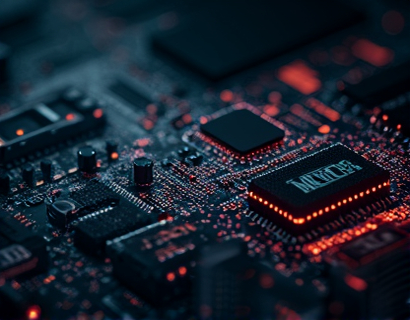DeFi Trading Elevated: Mastering Automated Market Makers for Optimal Automation and Liquidity
In the rapidly evolving world of decentralized finance, or DeFi, traders and enthusiasts are constantly seeking ways to enhance their trading experiences. One of the most transformative tools in this space is the Automated Market Maker, or AMM, particularly when leveraged through advanced smart-contract technology. This article delves into the intricacies of using AMMs to optimize liquidity management and automate trading strategies, providing a comprehensive guide to experiencing the pinnacle of decentralized trading.
Understanding Automated Market Makers
Automated Market Makers are decentralized protocols that facilitate trading without traditional order books. Instead, they use mathematical formulas to determine exchange rates based on the liquidity provided by users. This approach eliminates the need for intermediaries, reducing costs and increasing efficiency. AMMs operate by maintaining a constant product of two liquidity pools, typically represented as x * y = k, where x and y are the amounts of two assets in a pool, and k is a constant.
The beauty of AMMs lies in their ability to provide liquidity to assets that may not have significant market depth on traditional exchanges. By allowing users to deposit assets into liquidity pools, AMMs create a continuous market where trades can occur 24/7. This model is particularly beneficial for lesser-known tokens, as it ensures they have a liquid market without the need for a centralized exchange to list them.
Liquidity Providing: The Backbone of AMMs
To participate in AMMs, users must act as liquidity providers (LPs). LPs deposit pairs of assets into a liquidity pool, receiving liquidity provider tokens as a reward. These tokens represent their share of the pool and often come with additional benefits such as trading fee splits and potential yield enhancements. The more liquidity a user provides, the more they can earn from trading fees and other incentives.
The process of becoming an LP is straightforward. Users simply interact with the AMM's smart contract, specifying the assets and amounts to deposit. The smart contract then allocates liquidity provider tokens and updates the pool's balance. This setup ensures that liquidity is always available for traders, fostering a more dynamic and accessible market.
Optimizing Liquidity Management
Effective liquidity management is crucial for maximizing returns in the DeFi space. One key strategy is to diversify liquidity across multiple pools. By spreading investments across various assets and protocols, users can mitigate risks associated with market volatility and protocol-specific issues. This diversification not only enhances security but also increases the potential for cross-protocol yield harvesting.
Another advanced technique is the use of yield farming, where LPs actively seek out the highest yields by moving their liquidity between different pools and protocols. This requires constant monitoring of market conditions, token prices, and yield rates. Automated tools and bots can be employed to execute these strategies efficiently, minimizing manual effort and reducing the risk of human error.
Automated Trading Strategies with AMMs
Beyond liquidity provision, AMMs offer powerful tools for automated trading. One of the most popular strategies is arbitrage, which involves exploiting price discrepancies between different markets. AMMs can automatically detect and capitalize on these discrepancies by rebalancing liquidity pools, ensuring that the exchange rates remain consistent across platforms.
Another advanced strategy is the use of synthetic assets. Many AMMs support synthetic assets, which are digital representations of real-world assets like stocks, commodities, or other cryptocurrencies. These synthetics allow traders to gain exposure to a wide range of assets without directly owning them, opening up new opportunities for hedging and speculation.
Enhancing Trading Efficiency with Smart Contracts
Smart contracts are the backbone of AMMs, providing the automated execution of trading strategies. These self-executing contracts with the terms directly written into code ensure transparency, security, and efficiency. By automating trades based on predefined rules, smart contracts reduce the need for manual intervention, allowing traders to focus on higher-level strategy development.
For instance, users can set up recurring trades or stop-loss orders directly within the smart contract. This automation not only saves time but also ensures that trades are executed at optimal times, based on market conditions. Additionally, smart contracts can be programmed to execute complex strategies, such as dynamic rebalancing of portfolios or multi-asset arbitrage, further enhancing trading efficiency.
Challenges and Considerations
While AMMs offer numerous advantages, they also come with unique challenges. One significant concern is the impermanent loss, which occurs when the price of one asset in a liquidity pool deviates significantly from the other. This can result in LPs ending up with less value than they initially deposited, especially in highly volatile markets. However, this risk can be mitigated by carefully selecting assets with stable price relationships or using AMMs that offer features to minimize impermanent loss.
Another consideration is the gas fees associated with interacting with smart contracts on blockchain networks like Ethereum. High transaction costs can eat into profits, especially for frequent traders. To address this, some AMMs are exploring layer 2 solutions and optimizing smart contract code to reduce fees. Additionally, using tokens with lower gas costs or participating in networks with more efficient consensus mechanisms can help reduce expenses.
Future Trends in DeFi Trading
The future of DeFi trading, particularly through AMMs, is promising. As blockchain technology continues to evolve, we can expect improvements in scalability, lower transaction fees, and enhanced user experiences. The integration of AMMs with other DeFi protocols, such as lending and borrowing platforms, will create more comprehensive ecosystems where users can seamlessly manage their financial activities.
Moreover, the development of more sophisticated AMM models, such as those incorporating machine learning algorithms to predict market movements, will further enhance trading strategies. These advancements will make DeFi trading more accessible and efficient, attracting a broader audience and driving innovation in the space.
Conclusion
Mastering Automated Market Makers is essential for anyone looking to optimize their trading experience in the DeFi ecosystem. By understanding the mechanics of AMMs, implementing effective liquidity management strategies, and leveraging advanced automated trading techniques, traders can achieve greater efficiency and profitability. As the DeFi landscape continues to evolve, staying informed and adaptable will be key to success in this dynamic and exciting field.











































